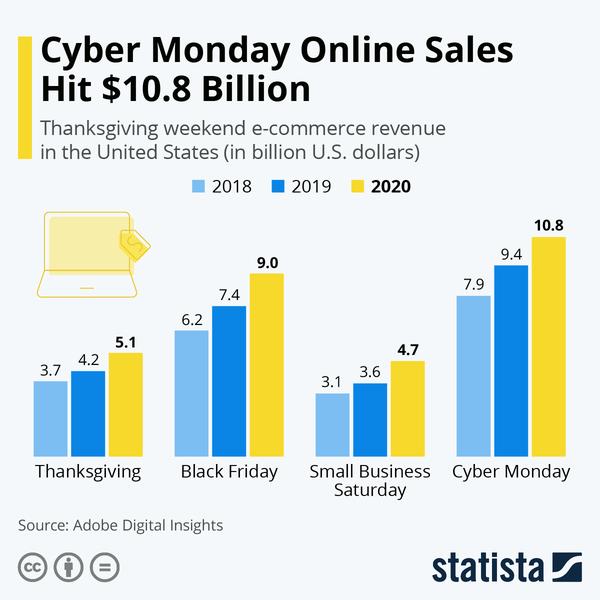The challenges of this unique holiday shopping season have made omnichannel commerce a necessity. With several states closing non-essential brick-and-mortar stores and others severely limiting the number of shoppers allowed inside, consumers embraced online shopping with gusto during Cyber Week — Thanksgiving Day to Cyber Monday — with a big surge in mobile ordering.
This is my sixth annual “Sales Report” for Thanksgiving Day through Cyber Monday, following installments from
2019
,
2018
,
2017
,
2016
, and
2015
.
Cyber Week Results
According to Salesforce, which collects data from over 1 billion global shoppers across more than 40 countries using its Commerce Cloud platform, digital sales grew substantially. Total digital sales for Cyber Week reached $270 billion globally and $60 billion in the U.S. Overall, ecommerce revenue in the U.S. was up 36 percent globally and 29 percent year-over-year. The number of online customers increased by 22 percent compared to 2019.
Globally, compared to last year, Thanksgiving Day experienced a 20-percent uptick in online sales, while Black Friday digital sales grew 23 percent. Cyber Monday digital sales in the United States shot up by 10 percent compared to 2019, according, again, to Salesforce.
Salesforce also reported that retailers with curbside, drive-through, and in-store pickup saw 32 percent higher online sales growth than retailers without those options during Cyber Week.
Thanksgiving Day
On Thanksgiving Day, when many physical retailers, including Walmart and Target, were closed, in-store U.S. traffic fell 94.9 percent year-over-year according to Sensormatic Solutions, a software and consulting firm that serves the retail industry.
Online U.S. sales on Thanksgiving Day rose 21.5 percent year-over-year to $5.1 billion, hitting a new record, according to Adobe Analytics data. The firm had originally projected $6 billion in sales. Adobe data is based on an analysis of 1 trillion annual visits to American retail sites, 100 million SKUs, and 80 of the country’s 100 largest retailers. Forty-six percent of the online purchases were made

on a smartphone
, according to Adobe.
Shopify, the ecommerce platform, reported that Thanksgiving Day’s peak sales-per-minute from global shoppers were about $919,000, an increase of roughly 34 percent compared with last year.
According to Salesforce data, global sales on Thanksgiving Day reached $62.2 billion, a growth of 30 percent over last year.
Black Friday
This year U.S. consumers skipped the pre-dawn line-up outside brick-and-mortar stores. Foot traffic was generally light owing to store closures, but it increased modestly in the afternoon and evening. Reduced inventories resulted in smaller in-store discounts, and many popular items such as game consoles either sold out early or were not available, most notably at Best Buy and Target, according to Coresight Research. Sensormatic Solutions estimated in-store store traffic to have declined by 52 percent from 2019.
American consumers spent $9 billion online on Black Friday, up 21.6 percent year over year, according to data from Adobe Analytics, which had originally predicted sales of $10.3 billion. Salesforce estimated global sales of $62.2 billion, 30 percent more than last year.
The peak sale
hour
on Shopify for the entire Cyber Week holiday occurred from 12:00 p.m. to 1 p.m. on Black Friday, with revenue of over $102 million.
On Black Friday, Adobe found spending on smartphones in the U.S. jumped 25.3 percent year-over-year to reach $3.6 billion, representing 40 percent of total online spending.
Hot items on Black Friday included Hot Wheels, Lego sets, Apple Air Pods, Apple Watches, Amazon Echo devices, and Samsung TVs, according to Adobe.
Retailers that offered curbside pickup had a 31 percent higher conversion rate of traffic to their sites — a reflection of how popular it’s become for people to buy online and retrieve purchases without stepping into stores. Adobe Analytics reports the number of orders fulfilled using curbside pickup has already grown more than 100 percent growth year-over-year for 2020 through the holiday week.
Cyber Monday
Based on Adobe Analytics data, American consumers spent a record $10.8 billion online on Cyber Monday, an increase of 15 percent over 2019. This made it the biggest online shopping day ever in the United States. However, revenue fell short of Adobe’s original forecast of $12.7 billion. In-store retail foot traffic declined by 23 percent from 2019.
Consumers wanting to take advantage of online deals drove nighttime shopping. Between 10 p.m. and 2 a.m. Eastern Time, U.S. consumers spent $2.7 billion. These last four hours accounted for 25 percent of the day’s revenue, with the peak hour from 11 p.m. to 12 a.m., according to Adobe. Consumers scooped up discounted computers, sporting goods, toys, electronics, and appliances.
Mobile accounted for 37 percent of Cyber Monday sales, according to Adobe.
Amazon Marketplace
While it does not provide sales by day, Amazon reported that its third-party sellers exceeded $4.8 billion in worldwide sales from Black Friday through Cyber Monday, an increase of more than 60 percent compared to last year.









